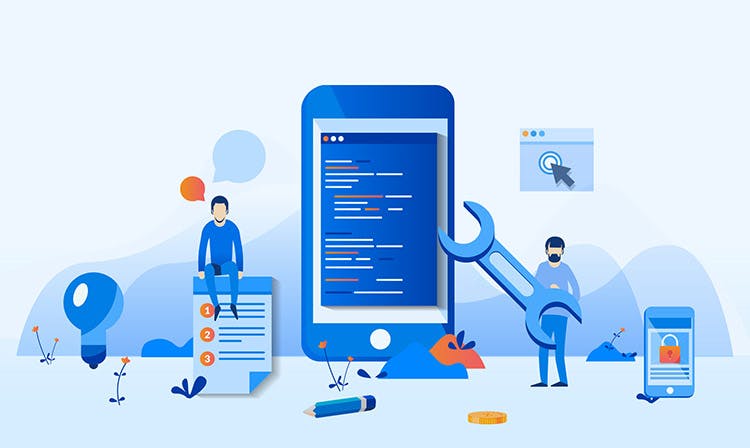How Do You Create Cost Effective Web and Mobile Apps
Article onTechnologyYou may have an idea for a killer App, but not necessarily know how to execute it. If you’re looking for quick tips on how to create an App, then take a look through our basic starting guide of all you need to think about before perusing your idea.

Web and Mobile Apps have taken the 21st century by storm, and are now at the heart of nearly all aspects of our daily lives, but how do you create cost effective web and mobile apps. With an App for helping you do pretty much everything and anything, the number of entrepreneurs that have been able to make huge profits thanks to converting a problem in the real world, into a solution in the technological world, is increasing by the day.
- Set your Objective(s)
- Properly Sketch the Ideas
- The Bulk of the Research
- The Wireframe
- Define the Back End of Your App
- Get People to Go Over Your Model
- Get Your Tools. It’s Time to Build
- Quick One: The Freelancer vs. Agency Conundrum
- Design the Look
- The Second App Test
- Implement Modifications and Adjustments
- The Beta Test
1. Set Your Objectives
When setting out to plan your App, it is important to note that this is a hugely creative process. Tech can help you with many things, but the creative side of the App development process comes from within. Grab a pen and paper and clearly set out what you really want to accomplish. Brainstorming your ideas on paper is the beginning of this process, not diving head first into any development work.
Make sure to consider the following:
- What do you want the app to do?
- How will you present it to people?
- How will it be useful?
A clearly defined set of goals is very important for success, and this is the very beginning of your journey.
2. Properly Sketch the Ideas
The next step in the app creation process is to develop a blueprint of what you want the app to look like. This is how you move your worded ideas into a visual representation.
This is especially true if you intend to sell your idea, or pitch to a host of potential investors – you will need to sketch out your ideas properly in order to make it as appealing as possible.
3. The Bulk of the Research
When it comes to developing an app, this is usually the first step that involves a large amount of technical knowledge. You will need to look online to see whether there’s an app that operates with the same functions as yours, and seeing how you can make your app better. You might have a bright idea, but odds are that someone else has already given it a go. You can learn from their mistakes, or build on what they’ve done right as well.
If your app is not a first (i.e. something like this has already been done by someone before), then it goes without saying that if you’re going to get any form of success on it, there has to be something unique about it (I mean, why should people flock to your platform if there’s no distinguishing factors?). Apart from making sure that your app will have a specific appeal, this also keeps you away from any litigation issues.
Read reviews about your competition, and you’ll be able to get information regarding what people think about them. When you understand what people liked (or didn’t like) about them, this information can then be put to work for you. Go back to your pen and paper and map out how you’re going to use this information to make their good characteristics work for you.
The next research step is looking at whether your app will get a green light. Essentially, this is looking at the Internet and examining copyright and technical blockages. You can’t waste time on an idea that won’t work, and you need to ensure that everything with regards to patents and technical issues are ironed out before making any kind of start.
The next thing is to look at marketing and sales. Look at your niche and the people your app is supposed to serve. Will they like it? Are you going to stick to the original design that you’ve made or will you have to go back to the drawing board to make any changes? If you have to make changes, where and when will the changes be implemented? Will you be marketing your app to millennials, children, or parents? By determining your audience, you’ll be able to focus and narrow your marketing efforts in the correct way.
When you’re done with your research and evaluation processes, then the fun stuff can begin. Start by looking for design ideas. There are various online platforms where you can log on and pick fancy and airing designs, so don’t be scared to let your mind run free!
4. The Wireframe
In tech speak, the “wireframe’ is just a story board. A wireframe is a document in which your design ideas are put on paper, to make it much clearer to communicate the idea to others. The functionality of the product in your wireframe will be the foundation from which your app is built, so be careful to get this right. There are various wireframe creation sites where you can go and bring your design and sketch ideas to life, and even add basic functionality tools like swipes and click throughs. Be sure to try a few different tools and find one that feels good with you and the way you work. We like InVision.
5. Define the Back End of Your App
Now that you’re done with the wireframes, you now have a story board showing how your app will work. The next step is to critique that functionality and make it better.
Using the wireframe, you now need to look into creating your servers, data diagrams/relationships, and API models. This is what is known as the “backend”. Your users will never see this functionality, but it is the underlying “brain” of your app, and is a crucial part of any app ecosystem. Help will be given to you by any outsourcing agency when it comes to this, but you need to have a rough idea of such things as, what details of my users will I collect? What information will my app ask for when signing up/logging in? How will my users pay for things? What information is private and what is public on the app? All these things should become more clear to you as you brainstorm ideas about the core functionality of your app and what you’re trying to accomplish
Whatever you come up with, you need to ensure that you create clear diagrams of how you think this functionality will work, no matter the method you are using to develop the app. These diagrams will help to properly direct anyone who is working on the project. In the event that you run into any technical issues, you can always review your wireframe, updating it as the project moves along.
6. Get People to Go Over Your Model
This is a step you need to perform with others. Get people in and show them your demo, and after they look at it, ask for any constructive criticism. Please note that at this stage that what you really need here is brutal honesty. You don’t need sympathy, but you also don’t need overbearing critics who completely dismiss your idea too.
Also, when your critics look through your demo, feel free to watch how they navigate the app. If any layout issues need to be reviewed, you can easily identify and improve upon it later. Be mindful of your users, and make sure you try to think like them.
The goal of this step is to finalize your app structure and final layout. Before your app gets a beautiful makeover by your design team, it needs to be able to function and perform its basic operations well, to avoid any repetitions and frustrations in the latter stages of development.
7. Get Your Tools. It’s Time to Build
Now that you have a solid foundation to work from, you can start pulling pieces together and build the app.
The first step involves a developer setting up databases, servers, and APIs. A quality app developer can do that for you, but you also need to remember all the feedback you got from your critics in the previous steps. Ensure that you put your modifications into the app to reflect the feedback that you got during your demo testing.
Next, sign up to the app stores. To get your app on the marketplace, create an account with both Apple and Google Play. This step might take a while, but you need to do it ASAP.
8. The Freelancer vs. Agency Dilemma
When working on a project, it is highly likely for you to need help with the app development. When it’s time for you to bring in expert help, you have two options; freelancers and development agencies.
To put it simply, a freelancer is a professional whose services are not tied to any company or organization. Freelancers look for work at cheaper rates, and they offer services on a personal and professional basis. However, an agency is a recognized body with staff members and a wide pool of talent at their disposal.
In truth, if what you’re looking for is transparency and reliability, it is always recommended that you go for a development agency. Here’s why:
- If you’re looking at it from the cost perspective, then you might be tempted to go for a freelancer. However, when you put hidden costs (such as time, energy, recruitment, etc.), things begin to scale up a bit. With an agency, you get a quote and you then know the amount to pay before any work begins.
- Accountability is an area where having an agency is certainly better. An agency can keep track of time, quality, and other variables, which results in business being conducted more efficiently and seamlessly.
- With an agency, you have a wide pool of talent to choose from. Not to say that freelancers aren’t talented themselves, but it is definitely much more secure when you have more than one person working on a project. You can get various opinions and ideas from different people that can save your app, instead of going down one path with a single developer doing all the work (good or bad!!). New ideas or solutions to problems can definitely come from the most unexpected sources.
- An agency is structurally more adept at handling projects that are complex and very cumbersome. If our app is a multi-purpose app that requires a lot of steps, you might be better served by a professional agency.
- Professionalism is another asset that you need to consider. An agency is a brand, and they understand that this brand needs to be protected. Thus, they are much more likely to conduct themselves in a more professional way.
9. Design the Look of Your App
This step involves being able to create your User Interface (UI). The UI is the visual aspect of your app. By understanding that people are attracted to beauty, it is essential that your app looks stunning! You also need to ensure that your UI is friendly and easy to navigate. Make sure to also keep your earlier feedback in mind, and ensure that your designers are able to work with that feedback in mind.
If you employed a graphic designer, then you need to ensure that you get amazing looking screens for your app based on your earlier wireframe. This is where a clearly presented wireframe document is so important, as it will clearly show the designer exactly how the app will need to function.
10. The Second App Test
After initial development has completed, you will need to go through a second test round. In this round, apart from having a functional app, you also have an interface to test. At this point, your app’s screens should work well, and your app should have a certain amount of visual appeal.
You need to run tests on both your app’s look and functionality in order to ensure that it looks and feels right to the user.
While you did a bit of this with your wireframe, this test is more detailed as you now have a working version of the app, albeit a very early version! The wireframe was just the skeletal framework of your app. Now you have an app that is both functional and demonstrates the complexities of the all its components working together.
11. Implement Modifications and Adjustments
You’ve given your prototype a test run, and you’ve probably seen that there are still a few adjustments that need to be made. Now that you’ve been able to see how your app performs, call back your earlier critics and have them look at it again.
Make sure to ask the same critics, as they’ll be able to tell you what they noticed and whether you’ve been able to improve on that. Again, be open to constructive criticism, as it is the only way you’ll be able to learn from what you’ve done. When you get any criticism, look at how to respond positively to it.
12. The Beta Test
You’ve now been able to look at your app from the viewpoint of several people, and you’re pretty sure that you’ve been able to develop an app that is innovative, unique, and problem-solving. The next step is to look at how well your app will perform in real life. This is known in the industry as the “Beta Test”, and is the first time your app will be unleashed to the world!
This process is actually simpler on Android, while things are a bit more controlled on iOS. Both parties have their merits and demerits, but this is the last hoop that needs to be jumped through in order to release your app.
Any Android device can accept your app file and run it in a live environment, and it can also provide you with an opportunity to always monitor any form of button press that you make.
However, with iOS you need a platform what’s called “TestFlight” to perform a beta test. There are strict rules on how you use Apple’s beta test platform, and one of its best features is the fact that you can have various testers look at the app before you launch it to the marketplace. Your outsourcing professional will be able to help you set this up.
Conclusion
With Beta Testing complete, the last step will be to launch your app into the marketplace and watch all your hard work start to pay off. But the journey doesn’t end there – you will need to market your app, improve your app based on reviews and feedback from the general public, and watch for any competition trying to take your share of the market!
If you’ve got a great idea for an app, and want to talk about your options for building an app business, why not contact us today!


